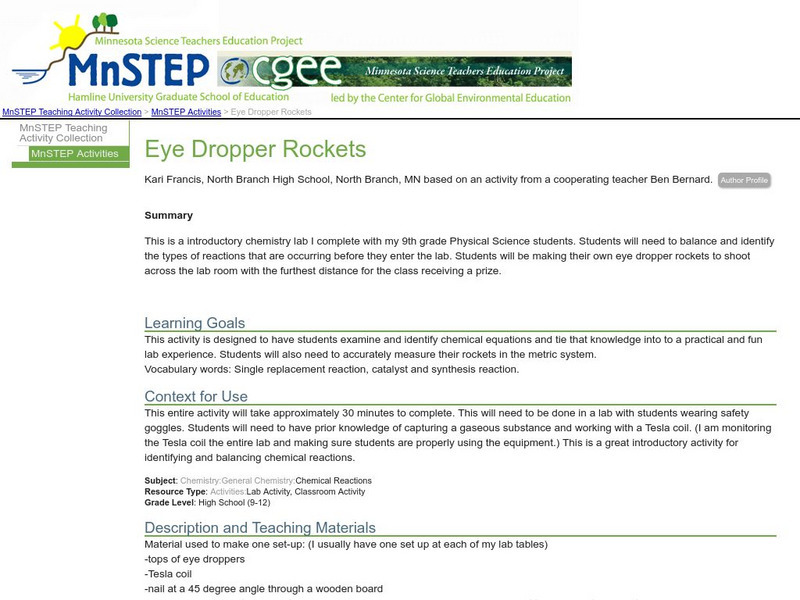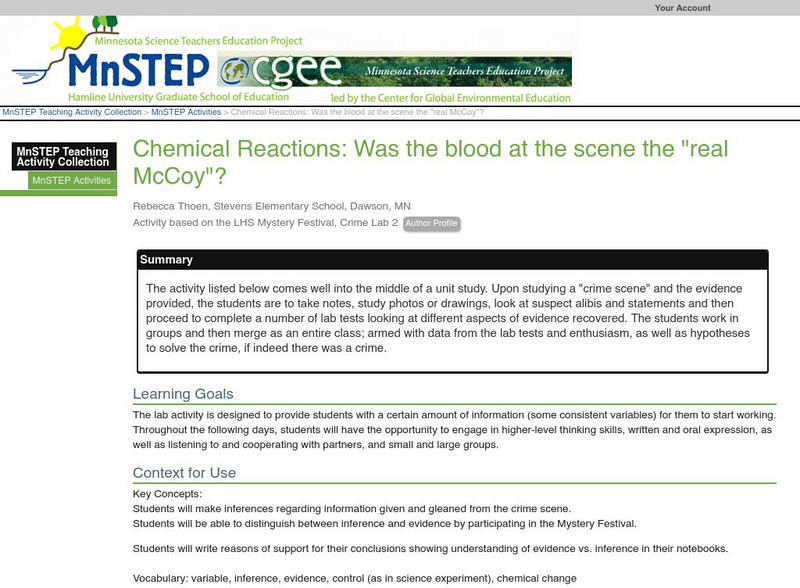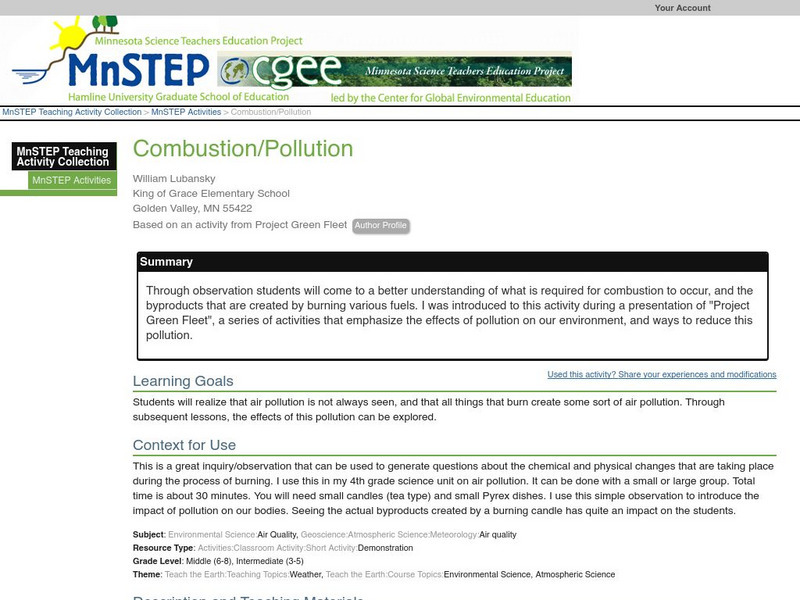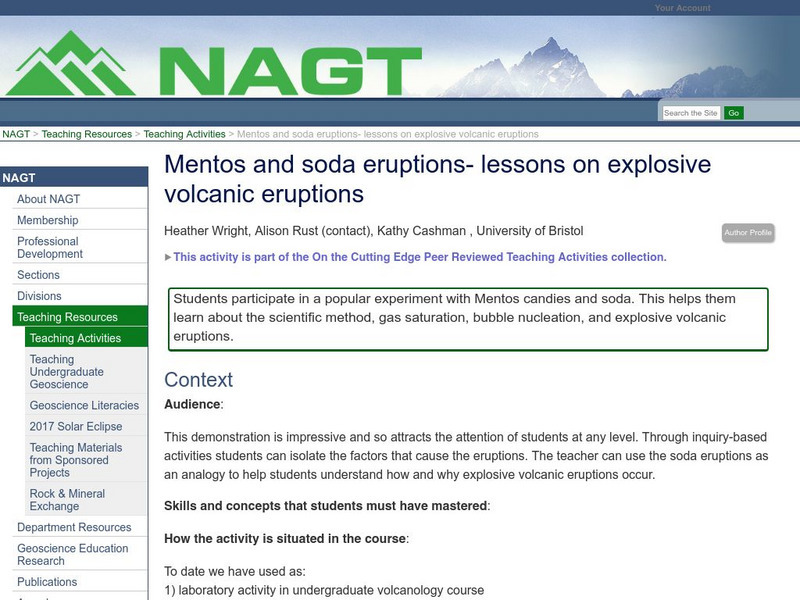Science Education Resource Center at Carleton College
Serc: Eye Dropper Rockets
Students balance and identify the types of chemical reactions, and then using the reaction knowledge, they make eye dropper rockets to shoot across the lab room with the ultimate goal of making it go the farthest.
Science Education Resource Center at Carleton College
Serc: Investigating Factors Influencing Rates of Chemical Reactions
This lab investigates the factors that influence rates of reactions. Students will develop a hypothesis, test the hypothesis, collect data, then draw a conclusion based on the data.
Science Education Resource Center at Carleton College
Serc: Chemical Reactions: Was the Blood at the Scene the "Real Mc Coy"?
The activity listed below comes well into the middle of a unit study. Upon studying a "crime scene" and the evidence provided, the students are to take notes, study photos or drawings, look at suspect alibis and statements and then...
Science Education Resource Center at Carleton College
Serc: Atoms and Molecules
As part of the introduction to the Periodic Table of the Elements, students will be introduced to the idea of atoms, molecules, and chemical reactions.
Science Education Resource Center at Carleton College
Serc: Combustion/pollution
Through observation students will come to a better understanding of what is required for combustion to occur, and the byproducts that are created by burning various fuels.
Simon Fraser University
Chem1 Virtual Textbook: Energetics of Chemical Change
Energetics of chemical change is a section of a larger overview on Chemistry, which covers a variety of aspects. This section focuses on energetics and equilibrium, and chemical energetics. Examples, formulas, and pictures are provided.
Simon Fraser University
Chem1 Virtual Textbook: Chemical Energy
With an overview of topics related to chemical energetics, this site provides a foundation to a study of thermodynamics and molecules as energy carriers and converters. Topics covered include how molecules take up thermal energy,...
Purdue University
Chem Ed: Chemical Reactions
Because atoms are neither created nor destroyed in a chemical reaction, the total mass of products in a reaction must be the same as the total mass of the reactants.
Upper Canada District School Board
Tom Stretton's Advanced Placement Chemistry: Electrochemistry
This online textbook chapter provides learners with advanced-level material on electrochemistry.
Open Curriculum
Open Curriculum: Chemical Reactions
Students will be able to describe what happens in a chemical reaction, and identify types of chemical reactions.
Other
Chemistryland: Types of Chemical Reactions Quiz
Seven problem online chemistry quiz that tests understanding of the five categories of chemical reactions.
Other
Science Alive: What Is Synthesis?
This lesson describes chemical synthesis in terms of building or breaking down molecules and discusses the value of chemical synthesis. Students will have a chance to play an interactive game that is analogous to the process of chemical...
Other
Science Alive: Chemical Reactions and How You Know When You've Made Something
In this activity, students carry out a chemical reaction in which two reactants (baking soda and hydrochloric acid) produce three products (sodium chloride, carbon dioxide gas, and water) and determine that the solid product (sodium...
Other
Science Alive: Changing the Starch in "Yams" to Sugar
This lab activity provides students with the experience of using their own enzymes to convert starch to sugar (a disaccharide called maltose), then testing to see if the conversion has taken place.
Alabama Learning Exchange
Alex: Types of Chemical Reactions and Predicting Products
The guided inquiry activity enables students to identify the five basic types of reactions - synthesis or composition, decomposition, combustion, single replacement and double replacement. Students will also begin to predict the products...
State University of New York
State University of New York: Hess's Law
Because reactions can be considered "additive," a series of reactions can be written like simultaneous mathematical equations and a net reaction determined by addition. To use this simulation, select individual reactions from the three...
State University of New York
State University of New York: Acid Base Reactions
This simulation shows the exact 25 different acid-base pairs and examines how to the extent which they react relates to the strength of the acid and of the base.
Virginia Tech
Types of Equations
After learning about and reviewing the types of chemical equations and rules for balancing, students can practice balancing equations on interactive quizzes.
Concord Consortium
Concord Consortium: Molecular Workbench: Collision Theory of Chemical Reactions
Watch an animation of atoms and molecules colliding that shows how these particles combine during chemical reactions. Change levels of energy to see how reactions are affected.
Concord Consortium
Concord Consortium: Molecular Workbench: How Chemical Reactions Happen
View this collection of simulations to gain a better understanding of how chemical reactions happen.
Clackamas Community College
Clackamas Community College: Distinction Between Chemical and Physical Change
Explains the difference between chemical and physical changes.
Clackamas Community College
Clackamas Community College: Single Replacement Reactions
A very useful site that includes examples of replacement reactions as well as exercises for practicing balancing replacement reactions.
Sophia Learning
Sophia: Chemical Reactions: Lesson 4
This lesson will present a basic understanding of the periodic chart of elements and how to predict chemical reactions based on given information. It is 4 of 9 in the series titled "Chemical Reactions."
National Association of Geoscience Teachers
Serc: Mentos and Soda Eruptions: Lessons on Explosive Volcanic Eruptions
Students will learn about volcanic eruptions, the scientific method, gas saturation, and bubble nucleation by participating in a popular experiment with Mentos candies and soda.




















